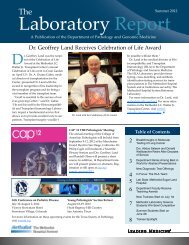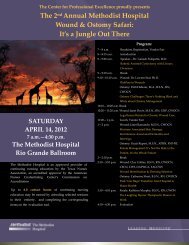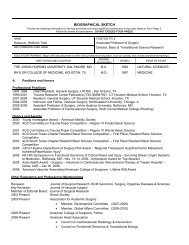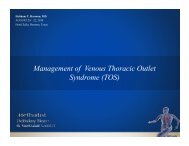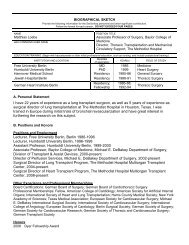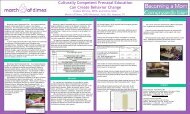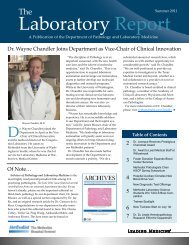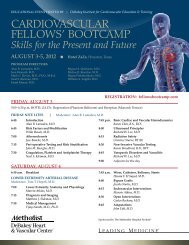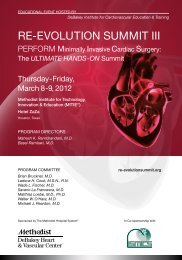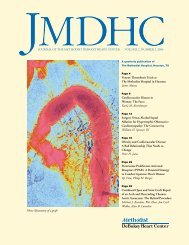DeBAKEy CARDIOvASCuLAR JOuRNAL - Methodist Hospital
DeBAKEy CARDIOvASCuLAR JOuRNAL - Methodist Hospital
DeBAKEy CARDIOvASCuLAR JOuRNAL - Methodist Hospital
You also want an ePaper? Increase the reach of your titles
YUMPU automatically turns print PDFs into web optimized ePapers that Google loves.
defects. useful display modes were: 1) Live 3-D Zoom<br />
during transeptal puncture and to identify dynamic<br />
catheter position relative to en-face views of the valve;<br />
and 2) Live 2-D biplane display (of 3-D data) to identify<br />
and track the guide wire tip during positioning across<br />
the PD. After device deployment, 3-D/color Doppler<br />
imaging provided immediate evaluation of occluder<br />
position and procedure success.<br />
Conclusion: Live 3-D TEE during PPvR provides<br />
important additive value regarding structural defect<br />
geometry, device delivery guidance, and immediate<br />
assessment of procedural success.<br />
Role of Cardiac Imaging in CRT<br />
Sherif F. Nagueh, M.D.<br />
<strong>Methodist</strong> DeBakey Heart & Vascular Center, Houston, Texas<br />
Congestive heart failure (CHF) carries a high mortality<br />
and is the leading cause of hospitalizations in<br />
the united States. Despite optimal medical therapy,<br />
many patients with CHF — due to a depressed EF —<br />
remain symptomatic. In these patients who also have<br />
a prolonged QRS duration, CRT has shown favorable<br />
effects on Lv function along with a significant reduction<br />
in adverse clinical events. However, around 30% of<br />
patients who receive CRT do not show clinical or functional<br />
improvement. Cardiac imaging can help identify<br />
patients who are more likely to benefit from CRT. This<br />
includes the assessment of the presence, severity and<br />
extent of mechanical dyssynchrony. At the present time,<br />
echocardiography is the most practical modality for this<br />
purpose due to its high temporal resolution. Several<br />
techniques have been evaluated including: M-mode,<br />
3-D, tissue Doppler, and speckle tracking. In addition,<br />
it is possible to identify the site with latest mechanical<br />
activation, and the presence or absence of contractile<br />
reserve. using echocardiography and cardiac magnetic<br />
resonance, it is possible to study the presence and distribution<br />
of scar tissue, which is one of the important<br />
Figure 1. 3-D TEE imaging<br />
assists in deploying and<br />
visualizing occluders used for<br />
repairing mitral paravalvular<br />
defects.<br />
factors that can predict the occurrence of reverse remodeling<br />
after CRT.<br />
The Role of Cardiovascular Magnetic<br />
Resonance in Detecting Coronary Artery<br />
Disease<br />
Dipan J. Shah, M.D.<br />
<strong>Methodist</strong> DeBakey Heart & Vascular Center, Houston, Texas<br />
With recent technical and clinical advances, cardiovascular<br />
magnetic resonance (CMR) has evolved from a<br />
promising research tool to an everyday clinical tool that<br />
is considered a competitive first-line test for common<br />
indications, such as detection of coronary artery disease<br />
(CAD). In fact, a 2006 consensus panel from the<br />
American College of Cardiology Foundation deemed<br />
the following indications as appropriate uses of stress<br />
perfusion CMR: evaluating chest pain syndromes in<br />
patients who have an intermediate probability of CAD<br />
with uninterpretable resting ECG or the inability to<br />
exercise; evaluating suspected coronary anomalies; and<br />
ascertaining the physiologic significance of indeterminate<br />
coronary artery lesions detected on coronary<br />
angiography (catheterization or CT). Currently, there<br />
are several CMR approaches for detecting coronary<br />
artery disease, including coronary magnetic resonance<br />
angiography (MRA), pharmacologic stress CMR with<br />
dobutamine (to assess contractile reserve and inducible<br />
wall motion abnormalities), and pharmacologic stress<br />
CMR with adenosine (to assess myocardial perfusion).<br />
Coronary MRA may be used to directly visualize<br />
coronary anatomy and morphology, but it is technically<br />
demanding. The coronary arteries are small<br />
(3–5 mm) and tortuous compared with other vascular<br />
beds that are imaged by MRA, and there is nearly<br />
constant motion during the respiratory and cardiac<br />
cycles. To counter these difficulties, several technical<br />
advancements have been made in recent years, including<br />
the advent of ultrafast steady-state free precession<br />
58 vII (1) 2011 | MDCvJ



